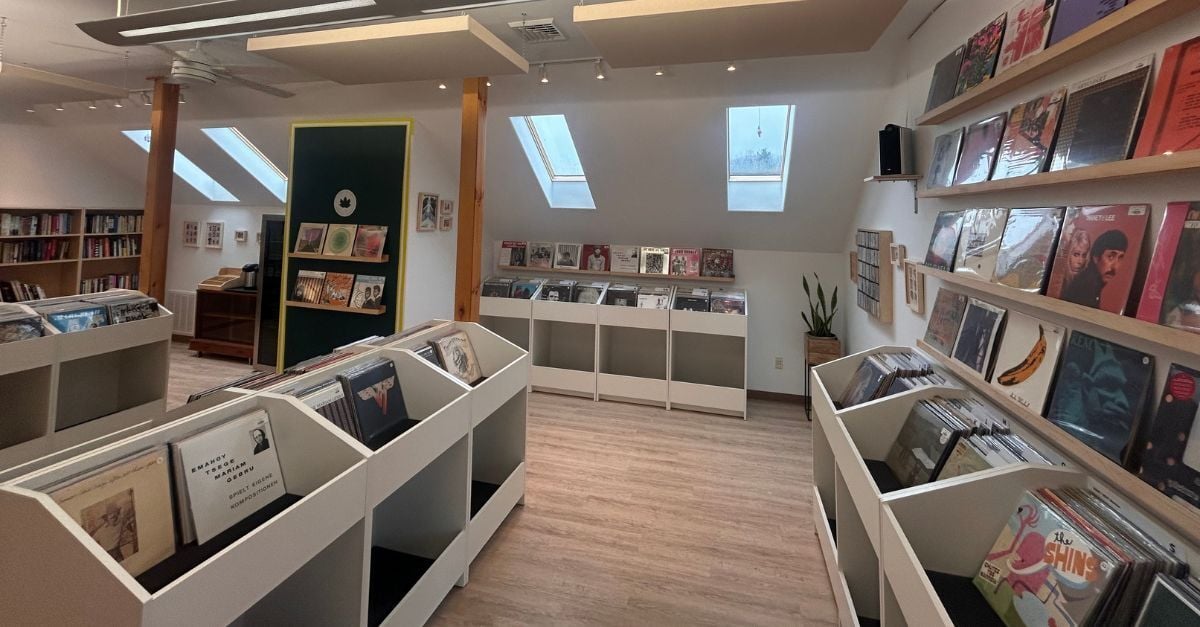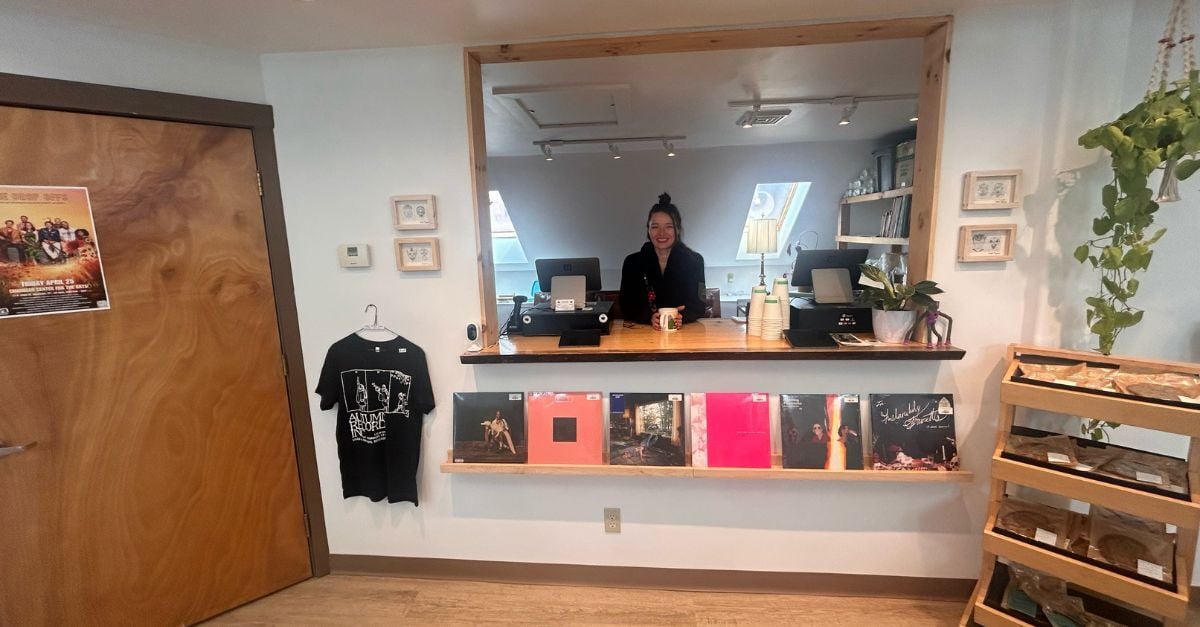In Waterbury, Vermont, there’s a space you don’t see coming.
Outside, the building looks ordinary. But climb the stairs and you’re looking up at vaulted ceilings. Natural light floods in from the skylights overhead. You step into 4,000 square feet of what feels like possibility.
This is Treehouse, a coworking and creative studio space started by Joseph Pensak, a veteran gallery and business owner who wasn’t looking to start it at all.
It started with an offer few get
 When the story starts, Pensak was happily running The Phoenix across the street, an art gallery and event space with studio spaces upstairs. “I was literally up a ladder when this man walked over and said, ‘Are you Joseph? Can I show you this space?’” he said.
When the story starts, Pensak was happily running The Phoenix across the street, an art gallery and event space with studio spaces upstairs. “I was literally up a ladder when this man walked over and said, ‘Are you Joseph? Can I show you this space?’” he said.
What the landlord showed him was that huge second floor, empty for close to five years. Once the office for an environmental engineering firm, it had been dismissed as “too much space” every time another office prospect toured it.
But then came the unicorn offer: “Pitch me on an idea. If I like it, I’ll do a build-to-suit for you.”
That kind of sentence doesn’t happen in real estate, at least not for people working in art, culture, or community spaces. Yet Pensak had it handed to him. Three months later, he had done his research and returned to pitch a model.
“A coworking space. A record store. Used books. A bunch of glass-doored studios for small businesses,” he said, ready for rejection.
The landlord said yes.
Too many things at once, until it makes sense
From the outside, it sounds scattered. A coworking space that’s also a record shop, coffee counter, lunch spot, and a row of glass door studios? Many people walked in early on and said, “Wait…what is this?”

But Pensak points out the exact reason it has worked: “From day one, all the studios were full. That covered the baseline. Then the record store took off. Coffee and food gave it more energy. That combination gives us room to let the coworking side grow slower.”
He compares it to having multiple fishing lines in the water. You don’t know which one will tug first, but you increase your odds when you cast more than one.
Local economic development folks have started describing Treehouse as a “Mary Poppins bag of businesses.” That works just fine for Pensak. “As soon as people walk in, they’re blown away. It’s surprising. It fits the magical treehouse idea.”
Waterbury is the right town at the right time
Why did this take root in Waterbury and not down the road in Stowe, the wealthier sister town? Pensak has an answer.
“Stowe has always been the perfect bubble. All money, all resources, everything done perfectly. Waterbury was the afterthought. This is where the state hospital was. People thought of it as a backwater,” he said.
But those kinds of towns are where artistic communities begin to reclaim buildings and put down roots. Pensak points out how artists and creative people make neighborhoods livable, and livability attracts everything else.
“There’s a reason they call the nonprofit here ‘Revitalizing Waterbury.’ But what really revitalizes a place is the arts. That’s what makes it so people want to live there,” he said.
Over 20 years, that’s exactly what happened. Sidewalks, granite curbs, music halls, galleries, and now Treehouse—layer by layer the town remade itself into a place that could sustain creative risk.
Where collaboration isn’t a program, it’s a culture
Four months into Treehouse’s launch, Pensak was asked whether programming was central to the space. His answer: not at first.
“When you’re starting up something like this, the first job is covering the basics. Making sure it works financially. Once the baseline is solid, then you can add layers,” he said.
Events are happening—the first “Arty Block Party,” monthly mixers, a menopause education workshop, and rentals for whoever needs a beautiful conference room. But what excites Pensak isn’t scheduling programming; it’s creating the conditions where collaborations unfold naturally.
“I live for that stuff,” he said. “You give people space in community, and with the right culture, cool things happen. They bring their friends, they connect, they start making together.”
Already, Treehouse is seeing it. A photographer tenant working with a graphic designer tenant on signage. A gardener sharing a studio with a yoga and Reiki teacher, turning it into a half-dried-flower market, half-event space. A jewelry designer meeting clients and hosting gatherings.

The space’s tagline of inspired work needs inspired space wasn’t just branding. It was a design principle. High ceilings, skylights, casual records playing in the background, local food in the café. Every detail was a bet that work feels different when you build an inspiring atmosphere. And those bets pay out in the form of collisions, collaborations, and community.
What landlords need to understand
Ask any coworking operator about landlords and you’ll hear the same groan: they want ten-year single-tenant leases, not complex spaces full of micro-tenants. Pensak knows it too.
He’s blunt about it: “I don’t think it can be taught. Either the landlord gets it or they don’t. If they do, you’ve hit the jackpot. If not, you’re wasting your breath.”
He should know—his landlord not only got it but loved it so much he poured investment into tailoring the space. He also serves as one of Treehouse’s biggest advocates.
Spaces like Treehouse don’t just depend on visionary founders. They require landlords willing to play the long game, to take on unconventional leases, and to build for a kind of return that doesn’t always show up in spreadsheets right away.
Slow is part of the model
If Treehouse were in a bigger city, Pensak is certain it would already be “blowing up.” Instead, he describes rural Vermont as having a built-in delay. “It takes Vermonters about three years to embrace a new spot,” he said.
So he’s planning on a long on-ramp, and is at peace with it. “If you assume it won’t work, you can be surprised when it does.”
Even then, one thing still frustrates him: “New Englanders are slow on change and new-ness. You have to really believe in what you’re doing and stay committed and have a long term launch plan,” he said with a laugh.
Business with soul still needs business
Pensak has spent years in nonprofits. He knows what it’s like to give and give until nothing remains. This time, with Treehouse, he sees things differently.
“I want to make it worth my while. We’re running a business here,” he said.
That means negotiating packages when one real estate agent in town joins and then recommends the space to their firm. It means designing an ecosystem where a local record store, a yoga teacher, and a remote worker don’t just coexist, but together sustain a bottom line.
“I’ve done the nonprofit model,” he said. “This is business with community baked in, but it has to work on both sides.”
Software only matters if it feels human
When Pensak started setting up Treehouse, he knew a patchwork of offerings such as studios, coworking desks, records, and coffee would need good systems underneath it. But he was also wary of technology that deadens the experience instead of enhancing it.
That’s partly why Coworks software got his attention. “Even the fact that I can chat with somebody, and it’s a person, and they say, ‘I’ll add this to the discussion list,’ that’s so rare,” he said. “It’s amazing how easy it is to set yourself apart by just being human.”
In his eyes, the difference is more than features. It’s philosophy. Too much of coworking’s reputation was shaped by the “stupid WeWork thing,” as he called it. That model chased scale and ignored soul. The byproduct was software built for landlords and investors, not communities.
But Coworks, he feels, is built for the people trying to build Treehouse-type spaces: local, eclectic, relationship-driven. Tools matter, but only if they support the underlying mission, bringing creative people together in ways spreadsheets can’t measure.
“You guys clearly have it in your DNA,” Pensak said. “That’s why I like working with you.”
Why coworking needs more spaces like this
Step back and you notice the pattern. The coworking industry is climbing out from the shadow of WeWork and other hyper-scaled, VC-driven models that collapsed under their own weight. Pensak sees Treehouse—and spaces like it—as part of the antidote.
“Those big models had to blow up to show everybody how not to do it,” he said.
The healthier model is local. Grounded in place. Flexible. Human. Built on relationships and collaboration, not headcount ratios and churn metrics.
That difference is felt not just in the members’ experience but in every conversation, every landlord handshake, every new artist moving into town. It’s what makes coworking a long game: slow, sometimes frustrating—but ultimately transformative.
Because as Pensak has already seen, once people have walked up the stairs into this big, light-filled loft space, they can’t quite stop talking about it.